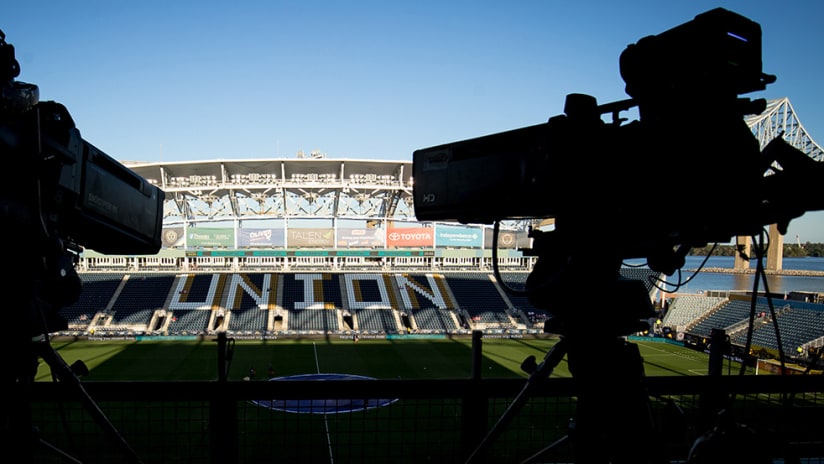MLS is back this weekend, and you’ll have all the games your heart can desire. Or at least 10 of them.
Now everyone enjoys soccer for different reasons, and everyone watches for different elements. If you’re looking for a few new cues, here are a couple tidbits I used while playing in the league. They're ones I always noticed on the field, and now look for when I watch on TV.
The basic gameplan – it's all in the CBs

US national team center back John Anthony Brooks dribbling up the field | USA Today Sports Images
It’s often difficult in the run of a game to decipher how a team is setup (especially knowing coaches sometimes try to trick you with what they put on the lineup sheet). How do you tell if a shift was spontaneous or preplanned and, to a larger extent, if it was good or bad? Well, everything slows down when a center back brings a ball forward unopposed.
When a center back has the ball and picks up his head to survey the field, say … after a goal kick, the picture becomes much more clear: Everyone on the field returns to his starting position and is (hopefully) doing the task the coach assigned. This allows you to see pretty much whatever both teams had written on the whiteboard prior to the game.
Ask yourself: What are the formations? Does everything match what the broadcast showed prior to the kick, or did the coaches try to pull some smoke-and-mirrors? How are the respective midfields set up? Where are the areas they're trying to overload, and what are the spaces they are leaving open?
This clearer picture of the gameplans adds depth to the chess moves made, which allows us all to yell at the screen with more conviction since we have a sense of what the players were actually supposed to do.
To drill down further, before the center back makes the pass, watch how the center mids play chess in the middle of the field. If your center midfielder checks to the ball and the opposing center mid tracks him 15 yards, the opponent is probably man-marking. If your player gets passed on to the next defender, then they are playing zonally. Once you sense how an opponent is defending, you can alter your movements and rotation. It’s a simple cue that can influence almost every pass in the game.
One more to track is the defending center backs' body posture – that positioning generally reveals their scheme for the game. If they are side on, with their bodies turned sideways, knees bent and ready to run, they probably plan to hold a higher line and follow the striker into the midfield to compress space. If the center backs are a little more upright and flat, they are more focused on organizing the players around them and less focused on chasing the striker.
As a result, defenders who maintain a less athletic stance are more likely to drop and protect the space behind them, allowing passes in front of them. To put this in US national team terms, it's the difference between the aggressive John Anthony Brooks and the more passive Omar Gonzalez. Once you notice how the center backs are scheming, you can predict where the openings will be on the field.
Transition: When intent is obvious

Minnesota United's Jerome Thiesson waits to take a throw-in | USA Today Sports Images
There’s a difference between a team’s formation and their intent: a team can run an aggressive high-press, but arrive flat on the day. The words on the whiteboard don’t determine the energy a team is going to have on the field (although they can help or hurt). Style means nothing without desire. And we’ve all seen teams look lackadaisical.
There are cues on this front throughout the early parts of a game, and they usually appear in the transition moments, when the ball goes out of bounds: Do the players look at the ground, or are their heads up so they can survey the field? Are they rushing to the ball, or are they using the opportunity to catch their breath? Are they yelling at each other to move quickly, or are they struggling to hold each other accountable?
Do they look energetic or do they look happy to get a break?
It’s a difficult – and incredibly frustrating – fact of life that people get complacent. You can generally spot it on a soccer field pretty quickly.
The mood after a mistake
It’s one thing to talk about the X's and O's, but there’s also an entirely separate and equally important realm of team chemistry. The tactical and technical abilities of the team don’t mean much if the players don’t enjoy playing together. Sometimes the best way to gauge the likelihood of a team winning is simply to watch the interactions between its players. The juicy moments generally arise when a player makes a mistake, and the body language tells the story.
It’s generally a bad sign when multiple teammates quietly turn away and shake their heads after someone errs. Similarly, it’s worrisome when guys put their hands up in disgust or slap the air but don’t say anything. If teammates aren’t going to encourage each other, you’d at least prefer they yell than be passive-aggressive.
If there’s shouting, you know the players feel comfortable enough to get pissed. You don’t need teammates to get along, you just need them to share respect. Shouting doesn’t scare or faze professional players; it’s when they start to hide the issues that you should begin to worry. So whenever you see players pointing and shouting and holding each other accountable, you can usually feel good about what you’re seeing. If it looks like 10th graders avoiding each other, issues might run deep.













